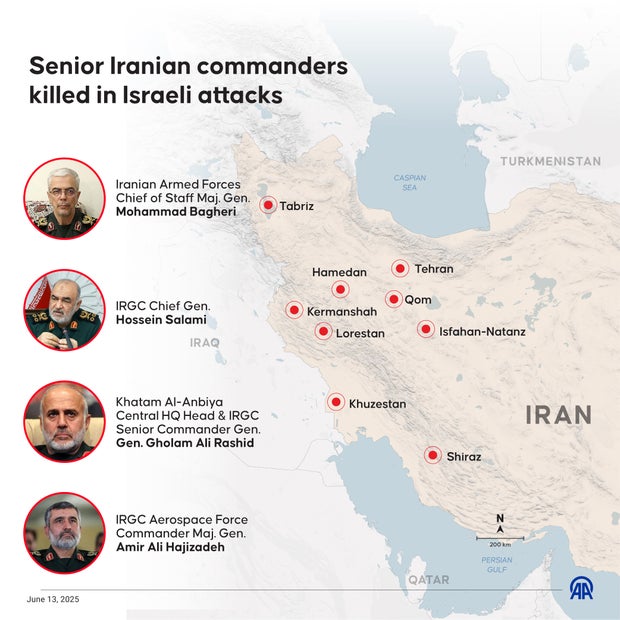Israel’s airstrikes on Iran early Friday targeted Iranian nuclear facilities, scientists and senior military commanders, the Israeli military said.
Israel Defense Forces said 200 fighter jets struck more than 100 targets in Iran and that the operation would continue for days. Those initial targets included multiple sites in Iran’s capital, Tehran, and Natanz, a key uranium enrichment site, officials said.
Israeli Prime Minister Benjamin Netanyahu called Israel’s strikes “a targeted military operation to roll back the Iranian threat to Israel’s very survival” in a video statement Friday.
In response, Iran launched more than 100 drones at Israel, many of which were intercepted by Israel’s air defenses.
The maps below show the confirmed locations of Israel’s initial strikes.

In a later round of strikes, the IDF said it had hit “the Iranian regime’s nuclear site in the Isfahan area,” located south of Natanz in central Iran.
“The strike dismantled a facility for producing metallic uranium, infrastructure for reconverting enriched uranium, laboratories, and additional infrastructure,” the IDF said in a statement.
Another enrichment site in Fordow had not been hit as of Friday morning, according to Iran and the U.N. agency. Later Friday, two explosions were heard near the site and state media said Iranian air defenses shot down an Israeli drone near the facility, according to Reuters.
Sylvie Husson via Getty
In Natanz, “the underground area of the site was damaged,” the IDF said in a statement.
“This area contains a multi-story enrichment hall with centrifuges, electrical rooms, and additional supporting infrastructure,” the IDF said. “In addition, critical infrastructure enabling the site’s continuous operation and the Iranian regime’s ongoing efforts to obtain nuclear weapons were targeted.”
No increase in radiation levels had been observed outside the Natanz site after the strikes, the United Nations’ nuclear watchdog agency, the International Atomic Energy Agency, said Friday morning.
Israel’s strikes also killed nuclear scientists and military leaders, the IDF said, including Iranian Armed Forces Chief of Staff Maj. Gen. Mohammad Bagheri, Commander in Chief of the Islamic Revolutionary Guards Corps Hossein Salami, IRGC Senior Commander Gen. Gholam Ali Rashid, and Maj. Gen. Amir Ali Hajizadeh, the head of the IRGC’s missile program.
Mehmet Yaren Bozgun/Anadolu via Getty Images
The U.S. was not involved in the Israeli strikes, Secretary of Sate Marco Rubio said.
The strikes came as the Trump administration has been trying to negotiate an agreement to limit Iran’s nuclear program. President Trump’s Mideast envoy Steve Witkoff was set to to hold a sixth round of talks in Oman over the weekend, but it was not immediately clear if those would still happen.
On Friday, Mr. Trump urged Iran to “make a deal, before there is nothing left.”
Iran’s President Mahsoud Pezeshkian said Friday on Iranian TV that the country would “strongly take action” against Israel in response to the attacks.
“The Iranian nation and the country’s officials will not remain silent in the face of this crime, and the legitimate and powerful response of the Islamic Republic of Iran will make the enemy regret its foolish act,” he said.
contributed to this report.


